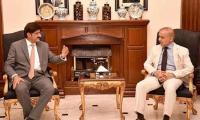At the US Senate Committee on Armed Services hearing earlier this week, the US Secretary of Defence Jim Mattis and the US CJCS General Joe Dunford asserted that the ISI maintains clear links with terrorists. Mattis went as far as claiming that while the government in Pakistan is busy defeating terrorism, the ISI is busy pursuing its own foreign policy objectives.
Senator John McCain, the chairman of the committee, who visited Pakistan in July and travelled to the border region between Pakistan and Afghanistan with General Bajwa and demanded to know why the US has failed to stop the Haqqani Network’s activities across the border. McCain added that if we all know the Haqqani Network’s street address in Quetta, why hasn’t the US military done anything to eliminate his sanctuary?
The accusations levelled at the government of Pakistan, the military and our intelligence community at the hearing were absurd. Mattis and Dunford recognised the fact that Pakistan has lost more troops than any other country in the war on terror. In the past, they have also recognised the tremendous sacrifices that the people of Pakistan have made since the tragic events of September 11, 2001. But for some reason, they continue to accuse us of providing sanctuary to terrorists. It is absolutely mindboggling.
Senator McCain’s claim that he knows the Haqqani Network’s street address in Quetta was a shocking admission. But it was unclear whether he had shared the location with the army chief in July. I doubt that he did. As a Pakistani, I implore Senator McCain to share the whereabouts with me. I can guarantee the US government that there will be many more Pakistanis like me who will be happy to go knock on that door.
There are some facts that US officials should consider before making these outlandish claims. The Afghan government only controls 60 percent of the country. Only one-third of the population and less than half the population supports the current Afghan government. So why would the Taliban or any other terrorist group associated with them seek refuge in Pakistan when they have a free rein in almost half of Afghanistan?
Furthermore, Pakistan has been able to clearly identify the location of Tehreek-e-Taliban safe havens in Afghanistan on the map. Why haven’t the US forces or the Afghans done anything to eliminate these sanctuaries despite our repeated requests and the overwhelming evidence of their signature on terrorist attacks on the Pakistani population?
The hearing was entirely fruitless. There was an utter lack of clarity from Mattis and Dunford. The entire committee kept asking for details about this new so-called strategy for the war in Afghanistan. During the session, Senator McCain said that it was “unacceptable” that six weeks had gone by since Trump announced this strategy and not a single detail had been shared with his committee. Speaking to the press, Senator McCain said that he would not approve anymore Trump-nominated officials at the Pentagon until he gets clear details about the new strategy.
Other members of the committee questioned how an additional 3,000 troops could change the battlefield equation in favour of the US-backed Afghan forces.
Mattis and Dunford tried to differentiate the new strategy from the old. They claimed that the new strategy will “bring the fight to the Taliban” and get rid of arbitrary deadlines have had a “psychological effect” on the Taliban because they now know that they can’t wait out the war and can’t kill their way to power. Mattis said that the US military operations would convince the Taliban that the only way to power and peace is through reconciliation.
Senator Warren questioned the assumptions of the new strategy, as described in the hearing. She argued that it was ridiculous to think that the Taliban would give up their arms because the US has decided not to give a deadline for withdrawal. Senator Warren further questioned the logic of the strategy by asking if the US was prepared to remain in Afghanistan forever.
Despite the positive picture portrayed by Mattis and Dunford in their testimony to the committee, a majority of the committee members remained disappointed. Mattis and Dunford said that polls taken in Afghanistan show that the people of Afghanistan rejected the Taliban ideology and that they were satisfied with US troops in the country. In the testimony, Mattis said that Nato and other allies in Afghanistan were happy with Trump’s strategy and received it well.
Secretary Mattis said this for the entire region and not just Afghanistan. That’s why he stopped in New Delhi on his way to Kabul. He said that his trip could not have gone any better than it had and that India was ready to do more to support the US mission and stabilise Afghanistan. But in reality, it did not go as well as the US had hoped.
Indian Defence Minister Nirmala Sitharaman made it quite clear that India was unwilling to put any Indian boots on the ground in Afghanistan. The US was clearly looking towards India to join the coalition of countries engaged in Afghanistan, but was flatly refused.
No matter how Secretary Mattis or General Dunford presented the concept of their new strategy, the committee remained highly sceptical of its ability to deliver a victory. US Senator Warren put it best when she asked: “Secretary Mattis, now for some of us this strategy seems like a déjà vu all over again … how will you convince the Taliban they can’t win on the battlefield, when 16 years of evidence suggests otherwise?”
The writer is a defence analyst in Washington DC.
Twitter: @umarwrites
A health worker administers polio vaccine drops to a child during a door-to-door polio vaccination campaign in Lahore,...
Armed militants of the banned Tehreek-e-Taliban Pakistan pose for a photograph in Orakzai Agency. —...
An aeroplane of the national flag carrier of Pakistan is seen in this file photo. — AFPWhile Pakistan considers...
Representational image of a graph depicting various variables. — APP/FileInitiated by the centre and fiercely...
In this picture taken on April 16, 2023, people throng a market area during shopping in Lahore. — AFPOne of the...
Honour crimes also target men. In Sikandar Ali Lashari vs The State, SHC upheld conviction passed by ATC for honour...







